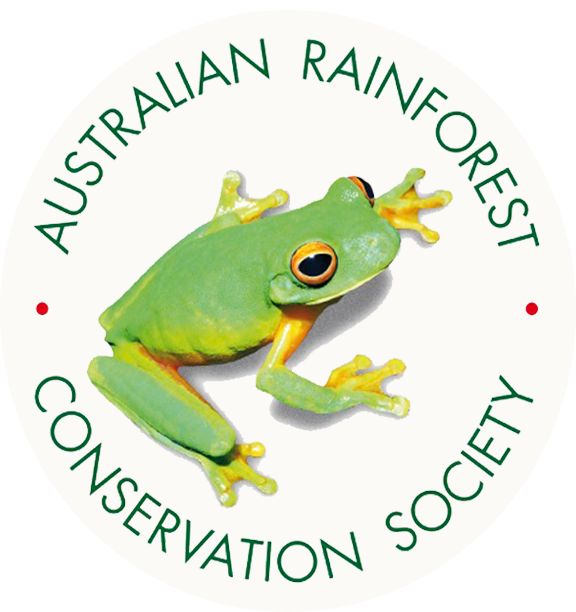 Springbrook Rescue
Springbrook Rescue
 Springbrook Rescue
Springbrook Rescue
| Home | The Vision | Springbrook — A Natural Wonder | The Springbrook Rescue Project | Support the Project | About ARCS |
Menu
Springbrook’s flora Flowering plants (angiosperms) dominate contemporary terrestrial flora and make the greatest contribution of all land plants to the earth’s biological diversity. Surviving basal or early evolving lineages are of great significance to the world’s natural heritage and our understanding of its ancestry and evolutionary future. Springbrook, and the Gondwana Rainforests of Australia World Heritage Area in general, support a range of plants that are of outstanding universal significance to science and conservation. The Wet Tropics World Heritage Area and the Tweed Caldera as part of the Gondwana Rainforests of Australia World Heritage Area are the world’s most significant survival centres for relict, persistent basal lineages of each major branch of the angiosperm evolutionary tree. Taken together with other original components of East Gondwana such as New Caledonia and South America, these refugia harbour the majority of the surviving, earliest ancestry of the earth’s flowering plants — an irreplaceable heritage of outstanding universal value. |
|
Trimenia moorei, Bitter Vine (Trimeniaceae) Trimenia is the only genus in the Trimeniaceae family and contains around 6 species. The map shows their distribution. Trimenia moorei is the only species occurring in Australia. The family belongs to the order Austrobaileyales which is recognised as one of the most basal groups of flowering plants. In fact, Trimenia moorei must rank as the most basal (primitive?) flowering plant in Australia, outside the Wet Tropics. |
|
|
Tasmannia insipida, Brush Pepperbush (Winteraceae) |
|
Aristolochia laheyana, Mountain Birdwing Butterfly Vine (Aristolochiaceae) is the food plant for the caterpillars of the vulnerable Richmond Birdwing Butterfly (Ornithoptera richmondia, FamilyPapilionidae; Subfamily Papilioninae). It is one of the largest butterflies in Australia with a wingspan of 12 to 16 cm. The Aristolochiaceae family is a member of the Piperales order, one of the earliest flowering plant lineages and placed close to the divergence of monocots (grasses etc.) from dicotyledinous plants in the early Cretaceous era. The fruits are capsule-like berries (unlike any other member of the family) with seeds buried in an aromatic red pulp and dispersed mainly by Brush Turkeys. Pararistolochia laheyana flowers are pollinated by insects, specifically male non-biting midges (Family Chironomidae, in the order Diptera). |
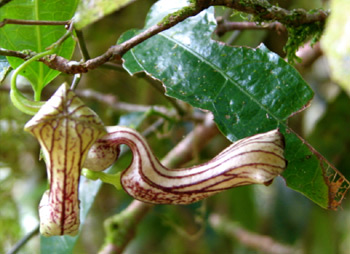 Photo: Keith Scott |
Doryphora sassafras, Sassafras (Atherospermataceae) The family is scattered on Gondwanan remnants — Australia, New Guinea, New Caledonia, New Zealand and Chile, indicating its ancient origins. Doryphora sassafras occurs from the SE Queensland to the southern coast of NSW. The only other species in the genus, D. aromatica, is restricted to NE Queensland. D. sassafras is a host plant of the hill-topping swallowtail, Graphium macleayanus (Papilionidae). This family of butterflies evolved at the same time in the early Cretaceous as their host plants. Doryphora and Daphnandra, another genus endemic to eastern Australia and occurring at Springbrook (Daphnandra tenuipes), are considered to be the oldest members of the family. |
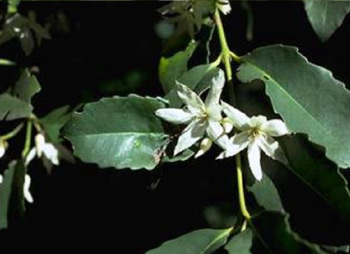 Photo: M. Fagg © Australian National Botanical Gardens |
Wilkiea huegeliana, Veiny Wilkiea (Monimiaceae) Wilkiea is a relatively small genus mostly (possibly completely) confined to eastern Australia. Three species, W. huegeliana, W. macrophylla and W. austroqueenslandica, occur at Springbrook. Like many other members of ancient plant families where pollination is carried out by primitive insects, Wilkea species are pollinated by tiny thrips (Order Thysanoptera). Wilkiea species are host plants for the uncommon Regent Skipper butterfly (Euschemon rafflesia, familyHesperiidae). The Regent Skipper, found only in eastern Australia, is unique among butterflies in having structures that lock the fore-and hind-wings together in flight. This locking mechanism is a characteristic of moths, hence the speculation that the Regent Skipper is a link between butterflies and moths from which they evolved. The Monimiaceae are among the most ancient of flowering plants.. |
|
|
Palmeria racemosa, Anchor Vine (Monimiaceae) There are 5 species of this genus in Australia. They are tall woody climbers but may be scrambling shrubs in younger stages. Two species are found at Springbrook, Palmeria racemosa which occurs from southeast Queensland to Batemans Bay in southeast New South Wales, and P. foremanii which has a more restricted occurrence from southeast Queensland to Ballina in northeast New South Wales. The other three species occur in coastal Queensland north of Mackay. Round, green “false fruits” rupture to reveal a bird-attracting red star-like inner surface with attached shiny black seeds. |
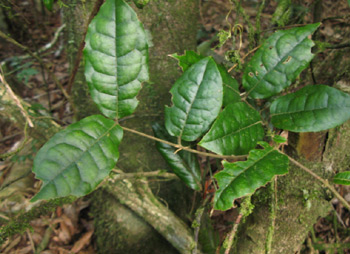 Photo: Keith Scott |
|
Cryptocarya rigida (Lauraceae) Rose Maple In Queensland, this laurel is essentially confined to the MacPherson Range with Springbrook as its centre. In New South Wales it occurs down the east coast to just south of Newcastle. It is an understorey shrub or small tree, and its shiny black fruits are eaten by the Rose-crowned Fruit-Dove in summer to early autumn. Cryptocarya, Beilschmeidia and Endiandra belong to the core basal lineage of the Lauraceae, with Cryptocarya sister to the other two. |
 Photo: M. Fagg © Australian National Botanical Gardens |
Eupomatia bennettii Small Bolwarra (Eupomatiaceae) The Eupomatiaceae have a basal position in the evolution of flowering plants. Eupomatia contains only three species and it is the only genus in the family. Eupomatia laurina occurs along the east coast of Australia and in New Guinea. E. bennettii has a more restricted distribution in eastern Australia and E. barbata is found only near Cape Tribulation in the Wet Tropics of Queensland. E. bennettii and E. laurina, both occur at Springbrook. Eupomatia species are pollinated exclusively by tiny weevils in the genus Elleschodes (Order Coleoptera) representing both an extraordinary specialization in primitive flower types (a calyptera, unique among all flowering plants) and highly specific mutualism. E. hamiltonii pollinates E. laurina whereas another species in the genus pollinates E. bennettii. |
|
|
Meiogyne stenopetala (Annonaceae) |
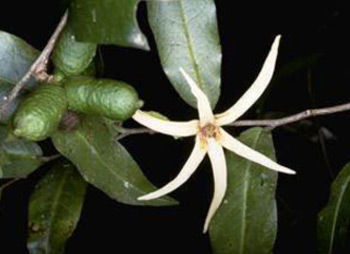 Photo: Ollerenshaw © Australian National Botanical Gardens www.anbg.gov.au |
Helmholtzia glaberrima (Philydraceae) Stream Lily H. glaberrima is found only in southeast Queensland and northeast New South Wales, Springbrook being a stronghold. Helmholtzia is clearly a relict genus, with another species in the Wet Tropics of Queensland and a third in New Guinea, indicating its previously wider occurrence. The buoyance of Helmholtzia seeds after germination favours dispersal especially along riparian corridors and permanently water-logged conditions.  Hermann von Helmholtz |
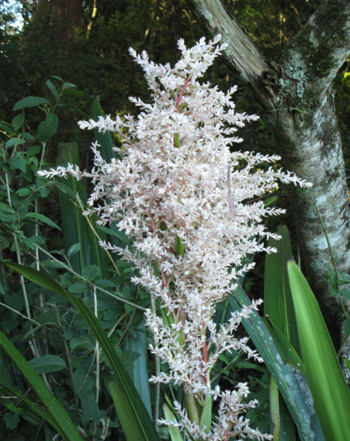 Photo: Keith Scott |
Ripogonum discolor (Ripogonaceae) Prickly Supplejack Ripogonum is a small genus of vines with 5 species in Australia, one of which also occurs in New Guinea, and one in New Zealand. Springbrook (and the Tweed Caldera) is something of a stronghold for the genus with all 5 Australian species being recorded. It is closely related to Petermannia (which also has its stronghold at Springbrook) and basal to the entire order Liliales. The oldest fossil records of Ripogonum from the early Eocene (~52–51 million years ago) are very similar to living species suggesting the family has had a long, unchanging history associated with permanently moist forests. These conditions are needed to maintain long-term viability of their seeds. Seeds that dry out over the many months required to germinate, fail to germinate. The related Petermannia also requires these same, moist germination conditions.. |
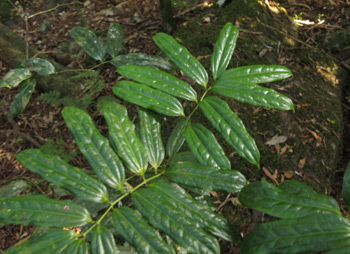 Photo: Keith Scott |
Alloxylon pinnatum (Proteaceae) Tree Waratah The Proteales is a key basal angiosperm order with Gondwanan origins. It is represented in Australia by the Proteaceae which has recently been recognised as basal to the two Northern Hemisphere families. The Proteaceae have the most extensive fossil record in the Southern Hemisphere of any taxonomic group. There are 4-6 subfamilies and the greatest diversity of subfamilies occurs in Australia, particularly in Queensland which also has the greatest diversity in Australia at the generic level. The Springbrook region contains 22 species in 14 genera from three subfamilies and nine of the 15 tribes of Proteaceae. . |
|
Anopterus macleayanus (Escalloniaceae) Macleay Laurel There are just two species in this genus, Anopterus glandulosus in Tasmania and A. macleayanus which occurs from the McPherson Range (including Springbrook) to the Comboyne Plateau inland from Port Macquarie. Such continental disjunctions reflect climatic sifting of species distributions that were widespread when rainforests covered a major part of the Australian continent. The distribution of Anopterus, together with other temperate rainforest genera such as Nothofagus, Acradenia, and Atherosperma have been the key to understanding southern hemisphere biogeography. |
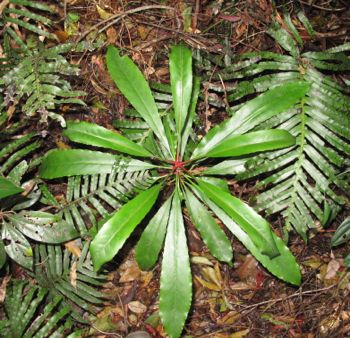 Photo: A. Keto
|
Berberidopsis beckleri (Berberidopsidaceae)
The order to which this species belongs, Berberidopsidales, is a very small group of just 4 species found only in eastern Australia and Chile, indicating its ancient Gondwanan origins. Berberidopsis beckleri is a scrambling climber and is found only in rainforests of central eastern Australia. The single other species, B. coralinna, is found only in Chile and is listed by IUCN as endangered. Streptothamnus moorei is the third member of the family Berberidopsidaceae and is the only species in the genus. It occurs from the McPherson Range, including Springbrook, to Tooloom Range in NE New South Wales. | 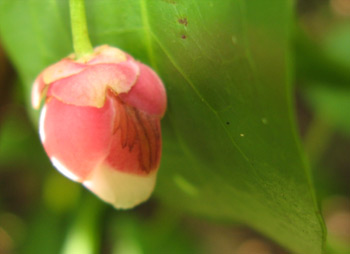 Photo: A. Keto 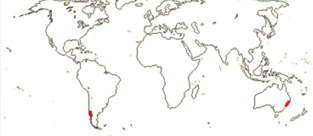 |
|
Carronia multisepalea (Menispermaceae) Carronia This uncommon woody climber is largely restricted to the remnants of the Mt Warning shield volcano with disjunct populations in the Blackall Range and Bellthorpe. There are just three other species in the genus Carronia, two in the Wet Tropics of Queensland and one in New Guinea, indicating a formerly much wider occurrence when rainforests were widespread in Australia. Around the world, moths belonging to the subfamily Catocalinae feed on members of the Menispermaceae. Carronia multisepalea is the host plant for caterpillars of the endangered southern subspecies of the Pink Underwing Moth (Phyllodes imperialis). The northern subspecies in the Wet Tropics feeds on another member of the Menispermaceae, Pycnarrhena novoguineensis. Menispermaceae, the primarily tropical, basal-most and largest family within the order Ranunculales, was a conspicuous component of the early Australian rainforests that reached their peak during the Early Eocene (the Golden Era of rainforests. Queensland’s present-day rainforests are exceptionally rich in relict narrowly restricted genera of the Menispermaceae (almost 20 per cent of all genera in the family), the continental scale disjunctions of which reflect this long evolutionary history in East Gondwana. |